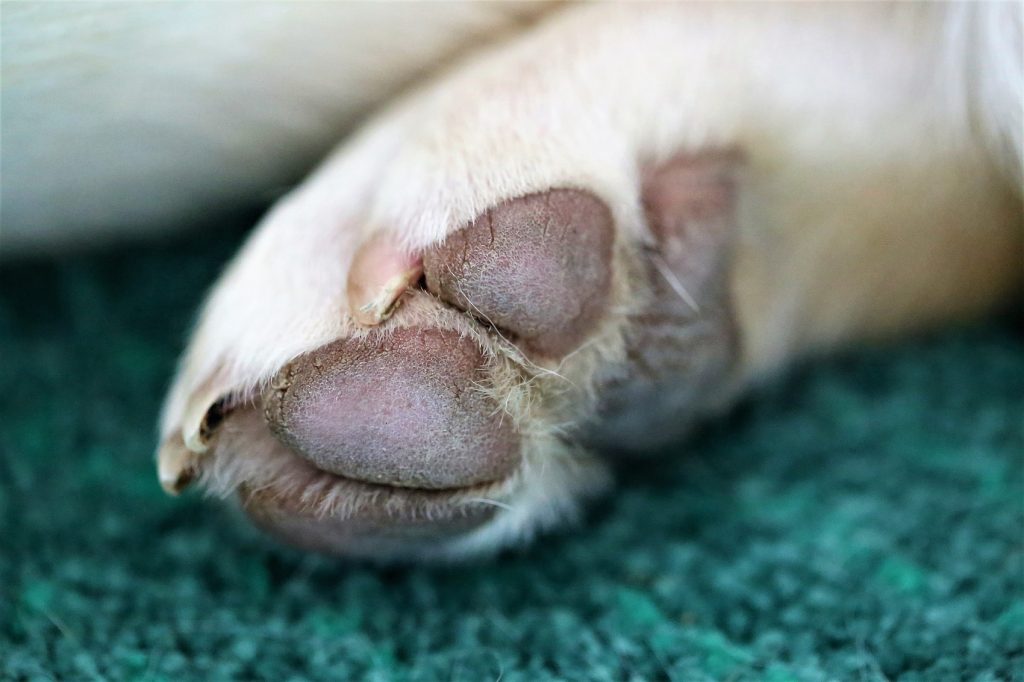If you’ve noticed that your dog has what looks like hair growing on its paw pads, it might be dealing with dog paw hyperkeratosis. This isn’t actual hair—it’s dry, tough skin that forms due to a condition known as hyperkeratosis, also called “hairy dog feet.” This skin issue mainly affects the paws and can cause discomfort or pain if left untreated.
What is Dog Paw Hyperkeratosis?
Hyperkeratosis is a condition where the skin becomes thicker and harder due to the overproduction of keratin, a protein found in hair, nails, and claws. In dogs, this excess keratin can cause rough, crusty growths on their paw pads (and sometimes their nose), giving the appearance of hair sprouting from their paws.
Is Hyperkeratosis Painful for Dogs?
Initially, hyperkeratosis isn’t painful, but over time, it can become very uncomfortable. If the condition progresses, your dog might experience enough pain to make walking or standing difficult. It’s important to regularly check your dog’s paws for signs of hard, dry skin, especially as they get older.

Is Hyperkeratosis Dangerous?
While it’s generally not life-threatening, hyperkeratosis can lead to infections or other complications if ignored. Early treatment and care are essential to prevent discomfort and further health issues.
What Causes Dog Paw Hyperkeratosis?
There are several factors that can lead to this condition:
- Genetics: Some dogs are more prone to hyperkeratosis due to genetic factors. For instance, Labradors may develop it due to a genetic condition known as nasal parakeratosis.
- Age: As dogs age, their skin thickens, especially in areas like the paw pads, making them more susceptible to hyperkeratosis.
- Canine Distemper: This serious disease can lead to paw hyperkeratosis, which is why it’s sometimes referred to as “hard pad disease.” Vaccinating your dog as a puppy can reduce the risk.
- Autoimmune Diseases: Conditions like pemphigus foliaceus, common in older dogs, can trigger hyperkeratosis.
- Zinc Deficiency: Some breeds struggle to absorb enough zinc, leading to skin issues that can include hyperkeratosis.
- Leishmaniasis: This parasitic disease, caused by sandfly bites, can also lead to hyperkeratosis along with other symptoms like joint inflammation and muscle pain.
Symptoms of Dog Paw Hyperkeratosis
The most obvious sign of hyperkeratosis is the growth of hard, crusty skin that resembles hair on the paw pads. As the condition progresses, other symptoms may include:
- Cracks and bleeding in the skin
- Loss of color in the affected area
- Frequent licking of paws
- Limping or reduced physical activity
- Secondary infections
If you spot any of these symptoms, it’s important to visit the vet for a proper diagnosis and treatment plan.

How to Treat Dog Paw Hyperkeratosis
There is no cure for hyperkeratosis, but there are ways to manage it and keep your dog comfortable. Here are a few options:
- Treat the Underlying Cause: If an underlying disease is responsible, such as an autoimmune disorder, your vet will treat that first, which may help manage the hyperkeratosis.
- Trim Excess Skin: Your vet can carefully trim away the thickened skin. With their guidance, you may be able to do this at home, but only after proper training to avoid harming your dog.
- Soak in Epsom Salt: A simple home remedy involves soaking your dog’s feet in warm water with Epsom salt for about 15 minutes. This helps soften the hardened skin and relieve discomfort.
- Apply Paw Balms or Ointments: Products designed for dog paw care can help keep the skin moisturized and alleviate the discomfort of dry, cracked skin. Applying these balms two to three times a day can improve the condition over time.
- Consult Your Vet for Severe Cases: If the hyperkeratosis is severe, your vet may prescribe medication or recommend special treatments like moisturizers or exfoliants.
Preventing Dog Paw Hyperkeratosis
While hereditary hyperkeratosis cannot be prevented, there are steps you can take to reduce the risk of the condition developing due to other causes:
- Regularly check your dog’s paws for any signs of dryness or hardening.
- Use moisturizing balms even if the paw pads seem healthy to prevent future issues.
- Keep your dog’s nails trimmed to avoid additional stress on the paws.
- Consider using dog boots or socks to protect their paws from rough surfaces.
- Ensure your dog is vaccinated against Canine Distemper to reduce the risk of this and other related issues.
Conclusion
While dog paw hyperkeratosis isn’t usually dangerous, it can lead to serious discomfort if not managed properly. By staying on top of your dog’s paw health and addressing any signs of the condition early, you can help keep your furry friend happy and active for years to come.













